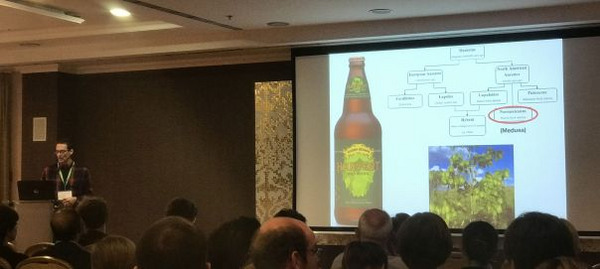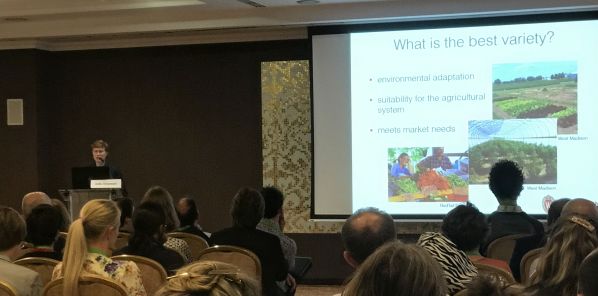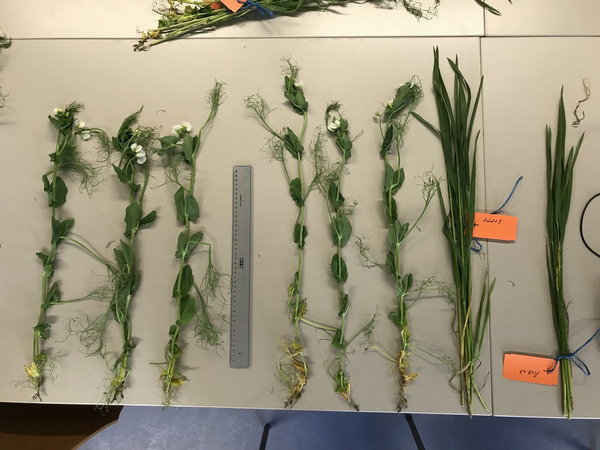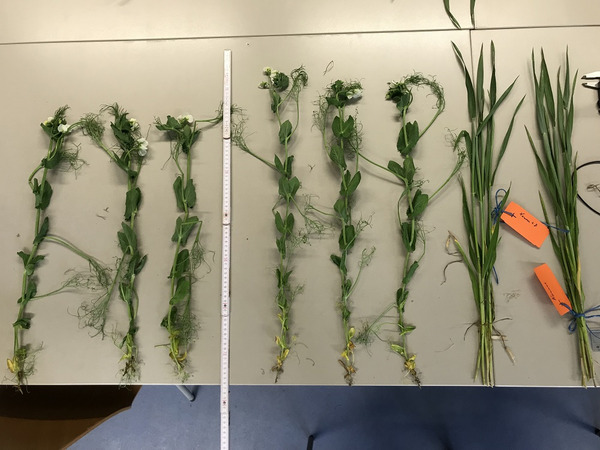I just had the opportunity to participate in an exciting and inspiring event, the ‘European Conference on Crop Diversification’ in Budapest. A powerful community addressing diversification of the agricultural and food sector is emergining. Below I discuss some of the highlights. I will definitely take some new ideas and, above all, energy away with me.
Using the beer industry as an example, Phil Howard explains the vicious circle of industrial dominance countered by resistance and alternatives, which are, however, ultimately co-opted.
Seed to Kitchen: participative breeding in Wisconsin
Julie Dawson from the University of Wisconsin is a real inspiration. Especially exciting is her participative breeding project ‘Seed to Kitchen’. Breeding lines and varieties are studied, cultivated and tasted together by/with breeders, growers, cooks and scientists. The first question was, of course, what actually is a good variety? Growers were then asked what their decision-making criteria were when choosing vegetable varieties. Taste, disease resistance and yield, turning out to be the three most important criteria. Professor Jim Meyers, in charge of vegetable breeding and genetics at Oregon State University, who was involved in the breeding of the blue anthocyanin-containing tomato Indigo Rose, is also participating as a breeder. Particular attention is paid to working with small market gardens or community-supported agriculture projects that serve local markets, communities and restaurants. According to Dawson, their needs are not well met by the big plant breeding companies. In this project, extensive tastings are also carried out applying so-called rapid sensory assessments/profiling. In contrast to tastings carried out by expert panels that need to be trained, rapid sensory profiling is faster, requires fewer resources and can be a valuable tool to select varieties for taste properties in participatory breeding projects. The online interface ‘Seedlinked’ is also interesting. It serves to collect on-farm data but also to process itautomatically allowing participants fast access to results. This avoids the bottleneck of data processing by scientists that can be very time consuming and thus effectively implements the crowdsourcing idea. Seed to Kitchen is an interesting approach to further develop the relationship between people and crops. It draws on modern technology but puts plants and people at the centre of breeding which is very different from the purely technology-driven approach of many large breeding companies.
The vicious circle of industrial dominance, resistance and appropriation
Phil Howard's contribution was very enlightening, on the one hand, entertaining but also resistance-provoking. Howard explained how alternatives and resistances to problematic dominant social regimes and institutions develop, only to be co-opted (appropriated) by them. Ultimately, capitalism appropriates every ideology, a vicious circle that leads to a perverse resilience of social institutions. As concrete examples he cited the seed market, animal breeding and the beer industry. He impressively showed how, against the dominant beer industry, a counter-movement of small craft breweries developed in the USA. When the strategy of the big companies to copy the craft beer taste and look failed, they bought themselves into the smaller craft breweries without being visible to the consumer (stealth ownership). You can find more information and current figures on the development of the seed industry on Howard’s website. In addition, the currently developing organic breeding initiatives will have to deal with appropriation and co-opting strategies by the big breeding companies as they grow.
Community seedbanks and ‘Erhalterringe’
Judith Féher’s (Hungarian Institute of Organic Agriculture ÖMKI) talk about community seedbanks in Europe was also very exciting. Féher and her colleagues are currently preparing a study in which they will examine the community seed banks on the basis of their organisational structure, financing and, above all, their management system for genetic resources. This is particularly interesting for our seed saving initiative in Germany (Verein zur Erhaltung der Nutzpflanzenvielfalt), which is in the process of establishing a new participatory conservation system for crop plants- the so-called ‘Erhalterringe’ conservation networks.
Breeding for species mixtures
Another interesting session topic was breeding of varieties for species mixtures. So far, plant breeding has concentrated on the breeding of varieties for monocultures. Analytical scientific methods as well as practical tools for breeding for species mixtures are far behind breeding for monocultures. For example, how can we find varieties that fit well together in mixtures and what selection criteria do we need in breeding for mixtures? Breeding for mixtures involves a lot of effort, as there are vast amounts of species and variety combinations, sowing strengths and spatial arrangements. Benedikt Haug from FiBL in Switzerland presented his work on this topic. Haug and colleagues applied a so-called incomplete factorial experimental design to evaluate variety performance in pea-barley mixtures. This experimental design, reduces the required effort yet delivers valuable data for new statistical modelling methods to determine the "General Mixing Ability" of varieties (GMA). For variety evaluation they not only included the yield of this variety but also its impact on the yield of the crop partner, the so-called associate effect. As our experimental work at Kassel University shows, wheat plants grow differently in mixtures than in pure stands and demonstrate an increased leaf area. This phenomenon – plant plasticity – can have a significant impact on mixture performance and should be considered in breeding for species mixtures.
There was also an interesting workshop on breeding for species mixtures.In this workshop,Haug presented the work of Peter Kunz's breeding company in Switzerland. Here, summer peas are bred in and for mixtures with barley. The workshop was mainly about how to advance the breeding of mixtures. A central aspect is to make the complexity of mixtures manageable and to limit the breeding effort. Experiments with simple mixtures (two species) could feed computational species mixture models to investigate more complex mixtures (three and more species). The identification of functional traits that influence species interaction and general ecological principles that hold true at least across related crop species (e.g., different cereal species) could also be a major advancement. Increased cooperation between plant ecologists and breeders would certainly be very fruitful as well as harnessing the potential of modern phenotyping platforms, which have so far largely been used for conventional breeding.
The financing of such work is of course a major issue. It is hardly to be expected that large breeding companies will seriously invest in this type of work.
Is a powerful diversification community emerging?
This conference and the social process it is embedded in reminds me a little bit of the historical events in the 1980s that brought the concept of biodiversity into the consciousness of our global society (Takacs 1996 ). During this time biodiversity emerged as a new bridging concept, along with a community of scientists from many disciplines and politically engaged people involved in nature conservation. This had a broad range of social and political consequences, such as the adoption of the Biodiversity Convention in Rio de Janeiro in 1992 or the introduction of the Habitats Directive (nature conservation) in the European Union.
The broad social ‘awareness’ of biodiversity in our society has also paved the way for scientific findings such as the Krefeld study to attract public attention and at least supporting concrete policy measures such as an improved nature conservation law in Bavaria, Germany. The concept of diversification in agriculture and its emerging community could have a similar impact in the agricultural and food sectors as biodiversity had in ecology and nature conservation. However, ecological, technological and social circumstances are very different from the 1980s. Technological development has had a major impact on how we organise communities and social movements, the world population is larger and the effects of climate change are ever more visible. An important step in strengthening the diversification community is certainly the formation of the Crop Diversification Cluster. This is a consortium of research projects investigating diversification strategies in agriculture. This cluster is mainly driven by Antoine Messéan (INRA, France).
Resistance to myself
It is therefore even more urgent to really resist obsolete social structures and behaviours and not to allow oneself to be co-opted. This is especially difficult in one's own everyday life. For example, at the conference buffet many people enjoyed a wealth of livestock products, while meat consumption was critically discussed during conference talks. I myself have also served myself abundantly on the cheese platter. Vegetarian options were available as booking options in advance,but how would it be to simply turn that around and make vegetarian food the conference standard and give the meat-eaters an option to opt-in to a meat diet? When booking the trip to Budapest, I also looked for flights first, as this seemed most convenient to me at the distance Witzenhausen-Budapest. However, a colleague was cool enough to find a good train connection during which I am now writing these lines. Maybe - like a good friend of mine - I should just drop flying completely. Resisting myself. Let's see...
Orginally published in German by Johannes Timaeus auf Biokultur.org
More information
Contact
Johannes Timaeus, Crop protection, Kassel University, Germany, johannes.timaeus@uni-kassel.de
Links
- Biokultur.org: Inspirationen aus Budapest
Literature
- Takacs, D. (1996). The Idea of Biodiversity: Philosophies of Paradise. Johns Hopkins University Press. More information at https://philpapers.org/rec/TAKTIO








 tap and then scroll down to the Add to Home Screen command.
tap and then scroll down to the Add to Home Screen command.